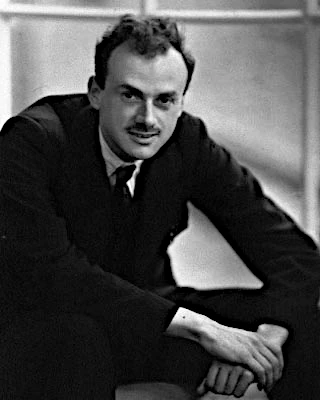
Born on August 8, 1902 in Bristol (England), Paul Adrien Maurice Dirac (1902-1984) grew up in a strict family environment. His father, Charles Dirac, a French teacher, imposed rigorous discipline that deeply marked young Paul. This austere upbringing developed in him a taste for precision and silence, traits that would follow him throughout his life.
After studying electrical engineering in Bristol (1918-1921), he turned to pure mathematics and then theoretical physics. In 1923, he joined the University of Cambridge where he worked under the supervision of Ralph Fowler (1889-1944), who introduced him to the revolutionary work of Werner Heisenberg (1901-1976) and Erwin Schrödinger (1887-1961).
In 1926, Dirac published his version of quantum mechanics, unifying Heisenberg's matrix approach and Schrödinger's wave approach. His famous equation, now known as the Dirac equation (1928), predicted the existence of antimatter before its experimental discovery by Carl Anderson (1905-1991) in 1932.
His formulation introduced the concepts of:
His major work, The Principles of Quantum Mechanics (1930), became the definitive reference in the field. Dirac expressed his scientific philosophy: "Physical laws should have mathematical beauty."
Known for his legendary taciturnity, Dirac only spoke essential sentences. A famous anecdote reports that a colleague once said to him: "I don't understand how you could discover antimatter," to which Dirac replied: "It's a matter of pure logic." This economy of words contrasted with the depth of his ideas.
Despite his apparent coldness, he married Margit Wigner (1908-2002) in 1937, sister of physicist Eugene Wigner (1902-1995), with whom he had two daughters. This marriage slightly softened his character without altering his absolute concentration on physics.
Dirac's contributions extend far beyond quantum mechanics:
| Concept | Dirac | Heisenberg | Schrödinger |
|---|---|---|---|
| Mathematical Approach | Operator Algebra | Matrix Mechanics | Wave Equation |
| Physical Interpretation | Unified Transformation | Uncertainty Principle | Probability Wave |
| Major Prediction | Antimatter (1928) | Uncertainty Relations (1927) | Quantization of Levels |
| Sources: Principles of Quantum Mechanics (Dirac, 1930); Philosophic Problems of Quantum Physics (Heisenberg, 1952); Collected Papers on Wave Mechanics (Schrödinger, 1928) | |||
After holding the Lucasian Chair of Mathematics at Cambridge (1932-1969) - the same position as Isaac Newton (1643-1727) - Dirac moved to Florida in 1971. He continued his research on the foundations of physics until his death on October 20, 1984 in Tallahassee.
His epitaph could be this statement he made in 1975: "I think it is more important to have beauty in one's equations than to have them fit experiment." A declaration that summarizes his entire scientific quest.